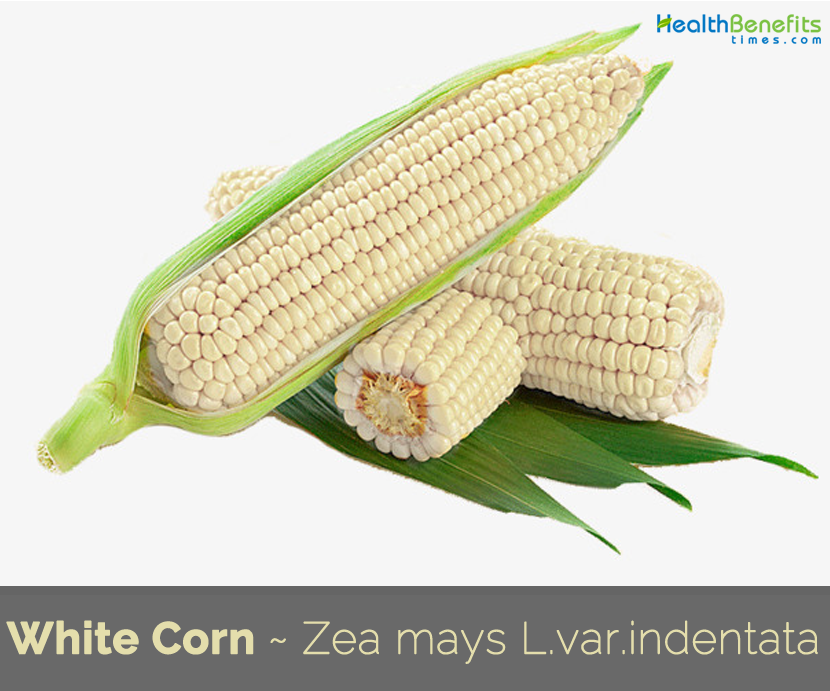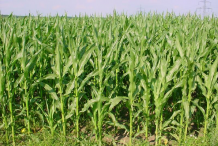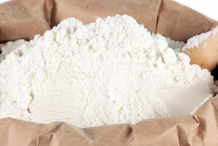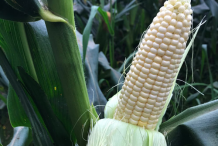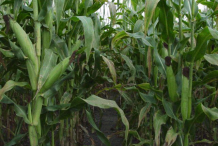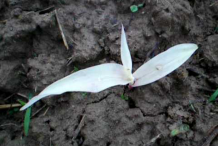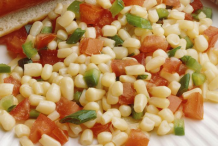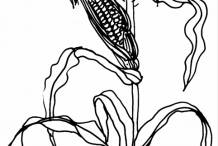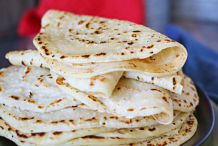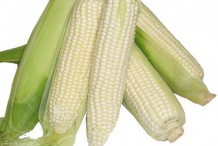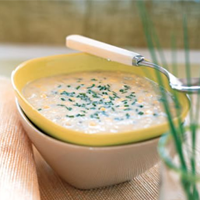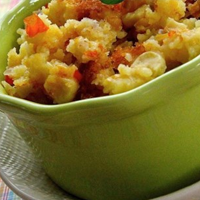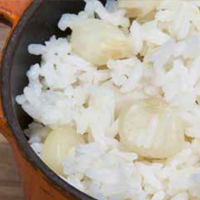The less white corn is cooked, the better the flavor and texture. White corn can be roasted, grilled, blanched, steamed, or pureed. White corn’s bright and sweet flavors lend well to pastas and salads. It pairs well with tomatoes, basil, cilantro, lobster, pork, chanterelles, truffles, shelling beans, cream, nutty cheeses, peas, summer squashes, fennel, citrus and scallops. Corn is dried and ground into flour for baked goods, tortillas, cereals and used as a crust/crisping agent for dishes both savory and sweet. Corn is also used for oil, as a sweetener in foods and beverages and as a base for beverage alcohol.
Plant Description
White corn is an erect, tall, fast growing, monoecious short lived annual grass that grows about 1–4 m (3 to 13 ft.) tall or occasionally 7 m; usually with a single main culm and one or occasionally 2 lateral branches in the leaf axils in the upper part of the plant. White corn is adaptable to a wide range of soils, but thrives best on well drained, well-aerated, deep soils containing adequate organic matter and well supplied with nutrients. It is sensitive to soil salinity. The plant has single erect stem made up of nodes and internodes.
Leaves are broadly linear 50–10 cm long by 3–7 cm wide arranged distichously, with leaf sheath surrounding the stem. Upper surface is hairy, lower surface hairless. The main culm produces at least 8 leaves, with temperate hybrids producing an average of 15 leaves and tropical hybrids producing up to 48 leaves. Conventional roots are supplemented with aerial brace roots, which protect against lodging. Flowers are monoecious, born in separate parts of the plant. Female flowers (ears) arise from axillary bud apices. Male flowers (tassels) arise from the apical stem. Its ears are wrapped in tightly layered pale lime green to white husks. One ear of corn can contain up to 400 kernels growing in rows lengthwise.
Fruit
The fruit of maize is a caryopsis, a dry indehiscent single seeded fruit. The pericarp (ovary wall) and testa (seed coat) are fused to form the fruit wall. Fruit also called kernel or grain and seed. Kernel composed of three main parts – the embryo, endosperm and fruit wall. Each ear contains 200–400 kernels which can be variously colored blackish, bluish-gray, purple, green, red, white and yellow. Both the kernels and milk of white corn are creamy white in color. The kernels have a very high percentage of sugar and water in their composition. When at their prime ripeness (the milking stage) the kernels will be tender, sweet and succulent. As the ear matures the water content decreases, the sugar turns to starch and the kernels become tough with a doughy consistency.
Health benefits of White Corn
White Corn provides numerous health benefits due to the presence of quality nutrients within. Besides being a delicious addition to any meal, it is rich in phytochemicals and offers protection against a number of long-lasting diseases. The well-researched and widespread health benefits of white corn are listed below.
1. Anemia Prevention
This is another one of those illnesses for women that are spreading more than ever. Anemia happens due to the profound deficiency of vitamins and minerals such as iron in your body. Body requires iron and folate to form new red blood cells. White Corn is a very good source of iron, per 166 grams of serving it provides an impressive 4.5 mg of iron.
2.Prevents Hemorrhoids
White corn consists of good amount of fiber content that helps in alleviating digestive problems such as constipation and hemorrhoids, as well as lowering the risk of colon cancer due to corn being a whole-grain.
Fiber has long been encouraged as a way to reduce colon risk, but insufficient and conflicting data exist for fiber’s relationship with preventing cancer, although whole-grain consumption has been proven to reduce that risk. Fiber helps bulk up bowel movements, which stimulates peristaltic motion and the production of gastric juice and bile. It can also add bulk to overly loose stools, which can reduce the chances of irritable bowel syndrome (IBS) and diarrhea. (1), (2)
3. Promotes Growth
White Corn is rich in vitamin B constituents, particularly thiamin and niacin. Thiamin is vital for maintaining nerve health and cognitive function. Niacin shortage leads to pellagra; a disease characterized by diarrhea, dementia, and dermatitis that is commonly observed in malnourished individuals. It is also a good source of pantothenic acid, which is an essential vitamin for carbohydrate, protein, and lipid metabolism in the body.
Deficiency of folic acid in pregnant women can lead to the birth of underweight infants and may also result in neural tube defects in newborns. White corn provides a large percentage of the daily folate requirement, thus preventing this condition. Kernels of corn are rich in vitamin E, a natural antioxidant that is essential for growth and protection of the body from illness and diseases. (3)
4. Weight Loss
Losing weight can be quite tough job. However, to lose weight consuming the right kind of nutrient rich foods is essential. White corn is the best snack for this, it is a wonderful source of energy and will also leave you feeling full for longer due to its fiber content. Popped corn without any salt, cooked with a tablespoon of coconut oil is the way to go.
5. Prevents Hypertension
White Corn consists of phenolic phytochemicals that help regulate blood pressure and prevent hypertension. There is also a good amount of vitamin B that is beneficial for the optimal functionality of your adrenal glands.
6. Lowers LDL Cholesterol
According to the Journal of Nutritional Biochemistry, consumption of corn husk oil helps to lowers plasma LDL or bad cholesterol by decreasing cholesterol absorption in the body. As mentioned earlier, this reduction in LDL cholesterol does not mean a reduction in HDL or good cholesterol, which can have beneficial effects on the body. They include the reduction of heart diseases, prevention of atherosclerosis, and a general searching of free radicals throughout the body.(4), (5)
7. May Prevent Alzheimer
It has been researched as a source of thymine, which is an antioxidant that sharpens brain functions. It also helps synthesize acetycholine, which in turn leads to an improved memory.
8. Prevents Diverticular Diseases
These diseases are often quite painful and lead to a lot of discomfort and suffering. Although researches are still being conducted on this subject, there has been an observation made on about 47,228 men that shows the benefits of consuming popcorn to prevent the symptoms of this disease from developing.
9. Weight Gain
White corn is a rich source of calories and is a staple in many places. The calorific content of corn is 606 calories per 166 grams, which is among the highest for cereals. This is why, it is often turned to for quick weight gain, and combined with the ease and flexibility of growing conditions for corn, the high-calorie content makes it vital for the survival of dozens of agricultural nations.(6)
10. Cosmetic Benefits
Cornstarch is used in the manufacturing of many cosmetic products and may also be applied topically to soothe skin rashes and irritation. Corn products can be used to replace carcinogenic petroleum products which are major components of many cosmetic preparations. Many of the traditional skin creams consists of petroleum jelly as a base material, which can often block pores and make skin conditions even worse.(7)
Traditional uses and benefits of White Corn
- Corn silk has been used as diuretic, antilithiasic, uricosuric, and antiseptic in many parts of the world.
- It is used for the treatment of edema as well as for cystitis, gout, diabetes mellitus, kidney stones, nephritis, and prostatitis.
- Corn kernel is considered to be diuretic and a mild stimulant.
- Corn is a good emollient poultice and is used for ulcers, wounds sore, swelling and rheumatic pains.
- An infusion of parched corn is taken for nausea and vomiting in many diseases.
- Decoction of fresh or dried stalk, cob as well as corn silk is used as a diuretic in Philippines.
- Decoction of roots, leaves, and corn silk is used for dysuria, bladder complaints, and bedwetting.
- Corn silk has been used for fluid retention and jaundice in China.
- Decoction of pith of cob as tea is used for stomach complaints.
- Corn silk has been used for treating urinary and venereal diseases and in cardiac and renal dropsy in Europe.
- Cob is used for kidney stones in Indonesia.
- Urino-genital problems are treated with prescriptions based on the whole or parts of the maize plant, especially a decoction of the corn silk, which is also used to treat jaundice.
- Maize leaf maceration is drunk to treat fever.
- Charcoal made from maize stalks is included in medicines to treat gonorrhea.
- An infusion from the burnt cob is used to wash wounds.
- Maize spike heated with powdered leaves of Glossonema boveanum used to treat intestinal schistosomiasis in Mali.
- Corn silk decoction is used as diuretic and depurative, and macerated maize leaves used to treat fever in Burundi.
- Powdered corn and leaves used as poultice for boils and carbuncles in Ghana.
- Decoction of the kernel and silk is used for management of diabetes mellitus in Southwestern Nigeria.
- Carbonized and powdered corn silk is used for edema and rash, and a decoction of the corn silk is used for hypertension in Togo.
- Corn silk used to treat convulsion, hepatic disorders, jaundice, and kernels also used for diarrhea, dysentery and liver disorders in Benin.
- In the Errachidia province of Morocco, dried, roasted kernels used to treat hypertension and the stalk for renal diseases.
- Maize stalk ashes are applied to the gums to treat tooth caries in Uganda.
- Decoction of corn flowers and slat is used as a mouth wash for tooth-ache in Burkina-faso.
- Sap from boiled kernels is applied externally for skin diseases in Kenya.
- Corn silk is used for treating measles and a towel dip in a decoction of corn cob is applied to bleeding nose in Nigeria.
- Decoction of the leaves and roots is used in the treatment of strangury, dysuria and gravel.
- Decoction of the cob is used in the treatment of nose bleeds and menorrhagia.
- It is a good herbal remedy in improving blurred vision.
- It reduces the tumor growth in the breast and the lungs.
Ayurvedic Health benefits of White Corn
- Hyperpigmentation: Apply Cornstarch directly to the affected area.
- Diaper Rashes: Cornstarch is in powdered form. It is easily available in the market. Sprinkle it on affected areas. Its moisture absorbing tendency helps to cure Diaper Rashes.
- Gout: Boil half a bowl of Corn. Sprinkle Lemon and Salt. Consume once a day.
- Uremia: Have it daily. Corn helps in proper urination and detoxification of the blood. It supports the proper functioning of the Kidney and treat Uremia. Prepare an infusion by adding 2 to 3 teaspoons of Corn in a cup of water.
- Athlete’s Foot: First, Rub a few amount of Corn flour on your feet. Then, heat up the oven to 330 degrees. Put 2 cups of Corn flour onto a plate and put it in the oven. Heat it till it to brownish. Rub it on your feet and toes. Leave it for 10 minutes. Dry out your feet with a clean towel. Repeat it regularly to prevent fungal infections (Note: Wash off your hands after the application unless it affects worse.)
- Ulcers: Burn the leaves of Jackfruit, Corn and Coconut Shell together. Mix with Coconut oil to make paste. Apply over the affected area.
- Urticaria: Take 1/2 cup baking Soda and 1/2 cup of Corn starch. Mix them well. Put it in a bath tub. Soak the body in this water for about half an hour. Repeat the process twice a week.
- Blemishes: Soak equal quantity of Almond and White Corn overnight. Grind it to make paste. Apply it on your face Spots.
- Melisma: Take 1/2 teaspoon of dried orange peel powder, 1 teaspoon of corn flour, 1 Teaspoon of olive oil and 1 teaspoon Yogurt. Mix all. Beat well. Apply over affected area. Let it dry. Wash with normal water.
Culinary Uses
- Maize grain is the basic staple food for the population in many countries of Latin America and Africa and an important ingredient in the peoples ‘diet’.
- Young, immature cobs of the sweet corn type are used as vegetable.
- Very young female inflorescences are savored as a fancy vegetable in stir fries or salad in Western countries and in Asia.
- Sweet corn kernels are boiled or steamed and often used as a pizza topping, in salads or garnishes.
- Raw unripe kernels may also be shaved off the cobs and processed into a variety of cooked dishes, such as maize purée, tamales, pamonhas, curau cakes, ice creams, etc.
- Corn on the cob is a sweet corn cob that has been boiled, steamed, or grilled whole; the kernels are then eaten directly off the cob or cut off.
- Creamed corn is sweet corn kernels served in a milk or cream sauce or in soups.
- Immature corn smut galls are enjoyed as an edible delicacy known as cuitlacoche, and sweet corn smut galls have become a high value crop for some growers in the northeastern United States who sell them to Mexican restaurants.
- Roasted dried maize cobs with intact semi-hardened kernels, coated with a seasoning mixture of fried chopped spring onions with salt added to the oil, is a popular snack food in Vietnam.
- Another very popular type of corn is popcorn which explodes when heated into puffed, fluffy corn which is a popular snack food eaten all over the world.
- Cancha a homemade Andean snack consists of toasted corn kernels which pop without puffing and is made from a special large grained corn called maize chulpe.
- Dried maize kernels are also processed into hominy or nixtamal or by soaking and cooking in an alkali solution usually lime and hulled.
- The Brazilian dessert canjica is made by boiling maize kernels in sweetened milk.
- Tepache, maize beer also known as chichi, a light refreshing beer, is also made from maize kernels and is consumed throughout Mexico, but nowadays various fruits such as pineapple, apple and orange are used.
- Chicha a fermented and alcoholic drink and chichi morada a soft drink are made from special types of maize and consumed in Peru.
- Bourbon whisky is made from mash that contains more than 51% of corn.
- Corn flakes made from milled corn is widely consumed as a crispy breakfast cereal, popular in North America and the United Kingdom, and in many other countries all over the world.
- Maize meal is made into various types of porridge or cooked corn meals in various cultures such as polenta in Italy, angu in Brazil, mămăligă of Romania, meali pap in south Africa, sadza , nshim a and ugali in other parts of Africa, hominy in southeastern USA or cornmeal mush in other parts of USA.
- Maize dough or corn flour is also used as a replacement for wheat flour, to make cornbread and other baked products.
- An unleavened corn bread called makki di roti is popular bread eaten in the Punjab region of India and Pakistan.
- Corn dough is made from freshly prepared hominy, and is used for making corn tortillas, tamales, tostadas, pupusas, arepas, pozole, pinole, atole and many other Latin American dishes.
- Corn starch is widely used for a number of purposes in cooking, as in the making of deserts and the thickening of gravy, soups, etc.
- Grain alcohol from maize is traditionally the source of Bourbon whiskey.
- Maize is also a major source of cooking oil (corn oil) and of maize gluten.
- Corn oil is oil extracted from the germ of maize and is used in baking and cooking.
- Corn oil is also a key ingredient in some margarine.
- Seed can also be sprouted and used in making uncooked breads and cereals.
- Roasted seed is a coffee.
Recipes
White Corn Chowder
Ingredients
- 4 to 6 ears of white corn, husks and silk removed
- 4 Tbs. (1/2 stick) unsalted butter
- 1/2 large yellow onion, minced
- 1 large celery stalk, minced
- 1 lb. russet potatoes, peeled and cut into 1/2-inch cubes
- 2 cups chicken stock
- 1 cup water
- 1 1/2 tsp. minced fresh thyme
- 1 cup half-and-half
- Salt and freshly ground pepper, to taste
- 3 Tbs. thinly sliced fresh chives
Directions
- Holding each ear of corn by its pointed end and steadying its stalk end on a cutting board, cut down along the ear with a sharp knife to strip off the kernels, turning the ear with each cut. Alternatively, remove the kernels with a kernel cutter. You will need 4 cups corn kernels. Set aside.
- In a large saucepan over medium heat, melt the butter. Add the onion and celery and sauté until soft, about 10 minutes. Add the potatoes, stock, water and thyme and bring to a simmer. Cover, adjust the heat to maintain a gentle simmer and cook until the potatoes are almost tender, about 8 minutes. Add the corn, cover and continue to simmer gently until the corn is tender, 3 to 5 minutes more.
- Transfer about 4 cups of the soup solids to a food processor along with enough of the cooking liquid to achieve a puree. Secure the lid and cover with a kitchen towel. Process until smooth and return to the pan. Stir in the half-and-half and season with salt and pepper.
- Reheat the soup gently over medium-low heat. Ladle into warmed soup bowls and garnish with the chives, dividing evenly. Serve immediately.
Sweet White Corn Casserole
Ingredients
- 1 (15.25 ounce) can sweet white whole kernel corn, undrained
- 1 (14.75 ounce) can cream-style corn
- 1 (8.5 ounce) package dry corn muffin mix
- 1 cup chopped onion
- 1/2 cup butter, melted
- 2 eggs, beaten
- 1/3 cup chopped red bell pepper
Direction
- Preheat oven to 350 degrees F (175 degrees C).
- Combine whole kernel corn, cream-style corn, muffin mix, onion, butter, eggs, and red bell pepper in a 2-quart casserole dish; stir.
- Bake in preheated oven until golden brown and the center is set, about 1 hour.
Rice with White Corn
Ingredients
- 3/4 cup fresh Peruvian white corn (choclos) kernels or fresh regular corn kernels
- 1 tablespoon canola oil
- 1 3/4 cups medium-grain white rice, such as Bomba paella rice
- 4 cups boiling water
- fine sea salt
Directions
- Rinse and drain the corn kernels.
- Heat the canola oil in a large saucepan over medium heat, add the rice to the oil, and cook, stirring, for about 1 minute, until the rice turns pale white, then add the corn.
- Pour in the boiling water and salt to taste and stir to combine.
- Cover the pan and simmer over low heat for 20 minutes or until there are air holes visible in the cooked rice.
- Fluff the rice up with a fork and serve.
Other facts
- Globally, just 21% of total maize production is consumed as food.
- Corn oil besides being edible is also used in the manufacture of soaps and paints.
- Starch from maize can also be made into plastics, fabrics, adhesives, and many other chemical products.
- Corn starch is also used extensively for laundry purposes.
- Sticky gum containing dextrin is used for sealing envelops, and on gummed labels.
- Corn is used for making alcohol.
- Cobs may be used to supply potash, and by distillation they can be made to produce acetic acid and acetone.
- Materials for the manufacture of nitrocellulose lacquers may also be obtained from them by controlled fermentation.
- Maize meal is also a significant ingredient of some commercial animal food products, such as dog food.
- In industrialized countries corn is used for animal feed, directly in the form of grain and forage, fodder, silage or sold to the feed industry.
- Maize breeders in North America and Europe focus on agronomic traits for its use in the animal feed industry.
- Various aerial parts of the corn plant can be used for ethanol biofuel production.
- Maize kernels can be used in place of sand in a sandbox like enclosure for children’s play.
- Corncobs can be hollowed out and treated to make inexpensive smoking pipes.
- Brown dye can be obtained from the cob.
- Dry corn stalks can be used to build fences.
- Maize kernels and cobs are also used as a biomass fuel source and are relatively cheap and home-heating furnaces have been developed which use maize kernels as a fuel.
- Maize is also used as a fish bait, called “dough balls”.
References:
https://www.itis.gov/servlet/SingleRpt/SingleRpt?search_topic=TSN&search_value=42269#null
https://npgsweb.ars-grin.gov/gringlobal/taxonomydetail.aspx?id=311987
https://npgsweb.ars-grin.gov/gringlobal/taxonomydetail.aspx?id=42207
https://pfaf.org/user/Plant.aspx?LatinName=Zea+mays
https://www.cabi.org/isc/datasheet/58357
http://www.missouribotanicalgarden.org/PlantFinder/PlantFinderDetails.aspx?kempercode=b138
http://www.floracatalana.net/zea-mays-l-
https://botanical.com/botanical/mgmh/c/corni103.html
https://plants.usda.gov/core/profile?symbol=zema
http://www.theplantlist.org/tpl1.1/record/kew-450362
Comments
| White Corn Quick Facts | |
|---|---|
| Name: | White Corn |
| Scientific Name: | Zea mays L. var. indentata |
| Origin | Mesoamerica, probably in the Mexican highlands |
| Colors | Milky White |
| Shapes | Long cylindrical consisting 200–400 kernels |
| Taste | Sweet |
| Calories | 606 Kcal./cup |
| Major nutrients | Carbohydrate (94.82%) Vitamin B6 (79.46%) Copper (57.89%) Iron (56.25%) Vitamin B1 (53.25%) |
| Health benefits | Anemia Prevention, Prevents Hemorrhoids, Promotes Growth, Weight Loss, Prevents Hypertension, Lowers LDL Cholesterol, May Prevent Alzheimer, Prevents Diverticular Diseases, Weight Gain, Cosmetic Benefits |
| Name | White Corn |
|---|---|
| Scientific Name | Zea mays L. var. indentata |
| Native | Mesoamerica, probably in the Mexican highlands |
| Common Names | Maize, Turkish wheat, Field corn, Corn, Indian corn, Grain maize, Cultivated maize |
| Name in Other Languages | lbanian : Misër I Ëmbël Amharic : Bäqqollo, Bekolo, Boqqollo, Yäbahər Mašəlla Angola : Espiga De Milho, Milho, Pungu, Pungu-Osovo, Pumu Arabic: Dhurah, Durah-Kizan, Durah-Shami, Dhurah Shâmîyah, Durahkizan, Durahshami, Hintahe-Runu, Hintaherunu, Khalavan, Khandarus, Khandaruz, Surratul Makkah, Zora Sukaria, Zurratul-Makkah, Zurratulmakkah Armenian: Egipitacoren Assamese: Gum Dhan, Gomdhan, Makoi Aztec : Cintli Azerbiajani : Gargy Daly, QarğÐdalÐ Bangladesh : Bhootta, Mokka Belarusian : Cucuruz, Mais Bengali: Bhutta, Janar, Jonar Benin : Bérétobourou, Gberebou, Gbade, Gbadye, Gbade, Gbado, Gbli, Ebli, Bayuri, Maana-Sore, Sege-Yore, Ebli, Abirri, Birri, Ebli, Ámeláamelá, Manzo, Agbado, Gbadé, Gbadésè, Gbadoda, Tchara Igbado Bosnian : Kukuruz, Zrno, Žulj Brazil : Cabelo-De- Milho, Milho Breton : Ed-Turki, Ed-Indez Bulgaria : Carevica, Zacharna Carevica Burkina Faso : Magno, Kaba ( Bambara ), Kanian ( Dagari), Maïs, Kamana, Kamana Burmese : Pyaung-Bu Burundi : Ikigori Catalan : De Blat De Moro Chechen : Hwaechk’a, H’äshk’a Chinese: Sok Mai, Shu Mi, Su Mi, Pāo-Siôuc, Bang Zi, Shu Mi, Yu Mi, Yu Shu-Shu, Hoan-Béh, Yu Mi, Yu Gu Zi, Bao Gu, Yu Mi, Shu Mi Comoros : Ndérou Cook Islands : Kōni, Kaoni Croatian : Kukuruz, Kukuruz Šecerac Czech : Kukurice Cukrová, Kukuřice Seta; Danish: Majs, Sukkermays Democratic Republic Of Congo : Masasi, Nzefu Zi Masasi, Ilefo Kia Masisi, Masangu, Poone, Muhindi Dutch: Maïs, Korrelmaïs, Turkse tarwe, Turkse koren, Maïs, Suikermais English: Maize, Turkish wheat, Field corn, Corn, Indian corn, Grain maize, Cultivated maize, Estonian: Mais, Lõhenev Mais, Penikeel Espernato : Maizo Farsi : Awâri, Balal, Javâri, Zorrat, Zurat Fiji : Corn, Maize, Sila Ni Vavalagi, Makai, Kono, Kon Finnish: Maissi, Sokerimaissi French: Maïs, Blà turc, Blà d’Egypte, Blà des Indes, Blà de Turquie, Maïs cultivé, Blé d’Inde, Maïs, Maïs Doux, Maïs Sucré French Haiti : Mayi Galician : Mainzo, Millo, Millo Grosso Gambia : Many s , Tubah-Nys Georgian : Simindi German: Körnermais, Echter Mais, Tarkisches Korn, Tuerkisher Mais, Tuerkisher Weizen, Kultur-Mais, Körnermais, Zuckermais Ghana : Kroju, Aburo, Awiaburo, Efíita, Aburo, Ò-Dóólí, Kaloana, Kaluwana, Eburo, Abele, Able, Blafo, Akplẽ, Aburoo, Aburow, Kpledzi, Kple-Ti Greek : Glyko Kalampoki, Kalamboki Guinea : Tubanyo, Kènkáabe, K-Akabe, Kö-Bay, Ts-Akabe, I-Rundù, Gέ-Maka, Maka, Makaré Sòâng, Nyóde, Woloma Kpway, Kö-Babo, Bura-Gué, Cissé-Nion, Diokoroni, Kaba, Mańo, Sagada, Kpèy, Kabè, Kémank Guinea – Bissau : Ntubanyo, Midjo Bassil, Cába, Tubanhô, Bumaadsa, Bumbaawa Hebrew : Tiras Hindi: Anaaj, मक्का Makka, मकाई Makaa’i, Anaaj, Bara Jauvar, Barajuar, Bhutta, Jawdra, Junri, Kukri, Makaa,Makai, Makkah Bhuttah, Makkah-Javar, Makki, Makya, Mukka- Jauri, Mungri Hmong Daw : Pob Kws, Pob Kws Qab Zib Huasa : Àgwààdóó Hungarian : Csemegekukorica, Kukorica, Tengeri Icelandic : Mais Indonesia: Jajong, Jagung, Jagung Manis Irish : Arbhar Indiach Isle On Man : Praase Italian: Granturco, Granoturco, Formentone, Grano di Turchia, Mais, Granoturco Da Zucchero, Granturco, Mais, Mais Dolce, Mais Zuccherino Ivory Coast : Kanian, Kamana Japanese: Toumorokoshi (Tômorokoshi), Fiirudo koon Kamba : Mbemba Kannada: Bottah, Dodda Jola, Gocinajola, Goinjol, Govina Jola, Hallina Jola, Hidi Jola, Kundige Jola, Makkai-Jola, Makkejola, Mekke Jola, Mekkejola, Meksikan Jola, Musukina Jola, Musukojola, Musukujola Kashmiri : Dŏda-Hĕdur; Maköyü Kazakh : Sacharnaja Kukuruza, Zhügeri Kenya : Mbembe ( Kikuyu ), Mûcakwe Khmer: Pôôt, poot Kirghizstan : Jügörü, Kanttuu Žugeru Kiribati : Kaon Konkani: Mako Korean: Ok soo soo, Kangnaengi Kurdish : Gēnmēsāmi Laotian: Khauz ph’ô:d, Khauz sa:li Latvian : Cucurkukurūza, Kukurūza Liberia : Gbu, Baai, Gbado, Gbai, Yibo, Yubws, Gbáazi, Nys, Kpai, Nyoru,’ Gbuu, Pamu Lithuanian : Daržo Kukurūzai, Paprastasis Kukurūzas Luxembourg : Mais Macedonian : Slatka Pčenka Madagascar : Somo-Katsaka Malay: Jagong, Jagung, Jagung Manis Malayalam: Cholam, Colam, Jagung, Makka Cholam, Makkaccolam Mali : Kaba, Mako, Manyò Maltese : Qamh Ir-Rum Manipuri: Chujak Marathi: Bhutta, Buti, Maka, Makaibonda, Makayi, Makka, Mako Mauritius : Maïs Mizoram: Vaimim Mongolian : Erdene Shish Morocco : Drâ, Drâ I-Hamra, Âssengar, Maïs, Mâser, Mekkâ, I-Mekki, Dra Squib, Tifsî Engafulî, Gafulî Nepal : Makai Nicobar Islands : Peòk Niger : Kòtòkòalí, Makkari, Massaru Kólgótí, Kolkoti Nigeria : Ansam, Ejama, Esut, Īkpāngkpà, Ekpoi, ọka, Dura Shami, Masar, Umm Abât, Umn Abat, Kâ K’pa, Kúmkpà, Kũkpa, Anjam, Siẹk, Daené, Dawai, Mapinawo, Aku Kwan, Yara Kàpas, Ajo Kwana, Nkurung, Damasar, Damasr, Pinau, Pino, Dir Kwozak, Masiri, Mìkĩ, Ápónò, Ansam, Aagba, Aagwa, Agwawa, Ka, Oka, Ìbòkpòt, Ìbòkpòt Úmòn, Ekpai, Nchamm, Áka, Àkân, Ókà, ọka, Nggulia, Butaali, Kaba, Puno, Pimisire, Pitigadin, Som Kiva,Okà, Àmbàbât, Nggulẹ, Gau Buza, Zakzak, Dákú-Hye, Agbado, Nyawi, Nyiawie, Agwado, Dááwàr Másàr, Dawaa Baa Másàráá, Hi Buku Hibẻ ku, Panu, Gupara, Àkpà- Akpa, Akpakpa, Àkpàkpà, Amirkpa, Makpa, Mkpà, Ikpapka, Ọ̀gbàdụ, ọkà, ịzọ́n Áká, Ọ́kaa, Àlàkpà, Ihwẹ, Likam, Acim, Azankpa, Kpankara, Za Kwa, Zaakim, Zakeim, Zakim, Zakpa, Zamkp, Amaû, Nywat Épat, Yakpat, Gọmbi, Khàrẹ̀bì, Limasára, Khauwa, Khavwa, Damasar, Damasr, Àrgêm, Másàr, Masarmi, Dákúše, Suwa Kpat, Okpat, Shwa Pa, Silok Akpat, Solak Akpat, Swá Pa, Nkwi, Aakalaaba, Som Kiva, Sopa, Imasarim, Khiya Masere, Masar, Babir, Akpe, Kwang Ufa, Esahma, Apenwa, Nsam, Fuan, Idãnyagọ, Kọọm, Tap, Apanau, Khiya Masere, Masar, Ọ́ghàk- Kpà, Fatuma, Misakono, Izitura, Za Ki, Zagin, Zakin, Mom Kwaẹ , Kâ-G’ba, Kumkpa, ẹ̀- Gú, Akwana, Haigim, Masar, Másármì, Dáza, Isangkpar, Nshamm, Aakaaba, Káawa, Kàba, Kwon Ga, Mapinawe, Mapinawin, Ọ̀bị̀àkà, Kpákìrà, Úbaakpâ, ẹ̀-Gû, Ì-Gù, Diptura, Kóomò, Idal Tibok, Kilbokta, Komberi Ma, Kkárábú, Ka Yiri, Kááda, Kai, Kaii, Idi-Mansẹri, Tsaa Kpat, Mu Buba, Béng Shwàa, Kofa, Likám, Jẹrldi, Pinodi, Gombie, Ikuleke, Ikuleko, Ikureke, Dákúše, ọgbado, S s ka ( Ukue ), Igbadoo, Akpoi, ọka, Àgbàdo, Àgwàdo, Egbáado, Ìgbàdo, ọkà, Óoka, Yángán, Kụl Bọkta Niuean : Ahi, Ahi Taina, Hana Norwegian : Mais, Sukkermais Persian: Bajri, Gandume-Makkah, Gaudume- Makkah, Gaudumemakkah, Hintahe-Rumi, Khoshahe-Makki, Khoshahemakki Philippines : Mais, Igi, Mais,Ngeya, Tibi, Tigi, Tongnga, Mañgi, Gahilang, Mais, Mait, Mais Polish : Kukurydza Cukrowa Portuguese: Milho, Milho Doce, Milho Forrageiro, Milho Grande; Milho Grosso; Milho-Maeês Romanian : Porumb, Porumb Zaharat Russian: Kukuruza obyknovennaia, Sacharnaja Kukuruza Rwanda : Ibigori Samoan : Fiso, Sana Sanskrit: Kandaja, Mahakaya, Mahakayah, Makaya, Makayah, Samputantastha, Shikhalu, Yavanala, Yugandhara Scottish : Cruithneachd Senegal : Ekôntibaba, Ékuntubaba, Sikutumbara, Husit, Sitikon, Kumorha, Maka, Makarbodiri, Makari, Mala, Mańo, Mańo, Búmaagi, Mańo, Bala, Maka, Makarbodiri, Mumbáawo, Púmaidsi, Pursin, Maka, Bala, Gwari Makka, Makarbodiri, Makka, Mala, Sataba, Maka, Makandé, Mbogi, Mboha, Mboxa, Morha, Wende, Mańo Serbian : Kukuruz, Kukuruza Obyknovennaia Seychelles : Maïs Shona : Bonore, Chibage, Chibahwe, Chibarwe, Chibere, Hupfu, Upfu Sierra Leone : Kã, Kã-Mo e , Kaŋ-D e , Khàŋ, Nkan, Nkang-Ntol, Nkison, Nkuskus, Kaaba, Di, Diom s k s , Kedǐ, Soã, Swahu, Nyue, Nyõ, K s n, Kutanki, Taŋki, Teher- Baŋwuridi, Dah s y s , Ny s Kama, Nys, Nyoo, Kaab e , Kabe, A-Mank, Nyóoroo, Nysrs , Nyu e , Tama-Nys, Kabé-Na Slovašcina : Koruza, Koruza Slovencina : Kukurica Siata Sorbian : Kukurica, Majs, Kukurica, Kurjace Woko, Majs Sotho : Mahea, Poone South Africa : Mafela, Mavhele, Mielies, Suikermielie, Mmidi, Mmopo, Umbila, Umbona Spanish : Cabellitos De Elote, Choclo, Elote, Mazorca De Maíz, Maíz, Maíz Azucarado, Maíz Comun, Maíz Dulce, Maíz Tierno, Mijo Turquesco, Trigo De Indias Sudan : Manio, ( Malinke ), Maka, Mako Swahili : Mahindi, Mhindi, Punje, Mafaka, Ngano, Gunzi, Kigunzi Swedish: Majs, Sockermajs Tagalog: Mais Tajikistan : Juvorimakka Tamil: Macca Cholam, Makka Colam, Makka-Cholam, Makkac-Colam, Makkaccolam, Makkasholam, Mokkaiccoolam, Turka-Cholam Tanzania : Dana, Mambatu’a, N/Ini Telegu: Jonnapothu, Makka- Zonnalu, Makkazonnalu, Mokka, Mokka Javanalu, Mokka Jonna, Mokka-Jonna, Mokkajanna, Mokkajonna, Mokkajonnalu, Mosanam, Zonaloo Thai: Khaaophot, Khaaophot on Tibetan : Āshom Togo : Bli, Ebli Tongan : Koane, Cingoma Turkish: Kokoroz, Mısır, Tatli Misir Turkmen : Mekgejöwen, Adaty Mekgejöwen Uganda : Duma Uyghur : Qonaq Urdu: Anaaj, Makai, Makka Uzbek : Makkajo’xori, Maccadjukhory Ukrainian : Cukrova Kukurudza Vietnamese: Ngô, Ngô Welsh : Corn Melys West Cameroons : Ngui, Ánsáng, Mbàsì, Ngun, Mbasi, Mukala, Ngui, Ngwi, Ngui, Begbabo, Mgbi, Kwata, Ngesáng, Mbwe, Gombie, Mbasi Yiddish : Kukuruzeh Zapotec: Lox yela Zulu : Mbila, Ummbila, Umumbu |
| Plant Growth Habit | Erect, tall, fast growing, monoecious short lived annual grass |
| Soil | Adaptable to a wide range of soils, but thrives best on well drained, well-aerated, deep soils containing adequate organic matter and well supplied with nutrients. It is sensitive to soil salinity |
| Plant Size | 1–4 m (3 to 13 ft.) tall or occasionally 7 m |
| Stem | Single erect stem made up of nodes and internodes |
| Leaf | broadly linear 50–10 cm long by 3–7 cm wide arranged distichously, with leaf sheath surrounding the stem |
| Flowering Season | July to October |
| Flower | Monoecious, born in separate parts of the plant. Female flowers (ears) arise from axillary bud apices. Male flowers (tassels) arise from the apical stem. Ears consist of a robust rachis (cob), with 4–30 rows of almost sessile spikelets bearing the caryopses (kernels). |
| Fruit Shape & Size | Long cylindrical consisting 200–400 kernels |
| Fruit Color | Milky White |
| Taste | Sweet |
| Plant Parts Used | Grains, stem, hairs |
| Season | September to October |
| Major Nutritions | Carbohydrate 123.27 g (94.82%) Vitamin B6 (Pyridoxine) 1.033 mg (79.46%) Copper, Cu 0.521 mg (57.89%) Iron, Fe 4.5 mg (56.25%) Vitamin B1 (Thiamin) 0.639 mg (53.25%) Leucine 1.917 g (51.87%) Magnesium, Mg 211 mg (50.24%) Phosphorus, P 349 mg (49.86%) Selenium, Se 25.7 µg (46.73%) Histidine 0.476 g 938.64%) Vitamin B3 (Niacin) 6.021 mg (37.63%) Valine 0.792 g (37.50%) Manganese, Mn 0.805 mg (35.00%) Isoleucine 0.559 g (33.43%) Threonine 0.588 g (33.41%) Zinc, Zn 3.67 mg (33.36%) Protein 15.64 g (31.28%) Vitamin B2 (Riboflavin) 0.334 mg (25.69%) Tryptophan 0.111 g (25.23%) Total Fat (lipid) 7.87 g (22.49%) Vitamin B5 (Pantothenic acid) 0.704 mg (14.08%) Lysine 0.44 g (13.16%) Potassium, K 476 mg (10.13%) |
| Health Benefits |
|
| Calories in 1cup (166 gm) | 606 Kcal |


